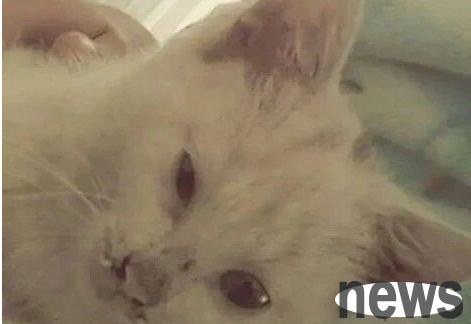It is said that cats are small animals that can tolerate pain very well. In addition, they are usually aloof and mysterious, so many times, we don’t even know that they are injured. But I never expected that a cat can endure pain so well!
Kitten Coconut Milk was originally an unwanted stray cat. Fortunately, it was picked up by a little girl in Wuhan. At that time, she saw it squatting on the roadside with swollen eyes, but it was in good spirits and looked quite lovable, so I picked it up.

When I first picked it up, the cat was all dirty, as if it had just come out of a coal den, and there was paint on its face that couldn't be wiped off with anything. But the little girl didn't give up. She still followed the procedure, dewormed the cat, vaccinated it, and gave it a bath.
After washing it, I saw that the cat's hair was all white except for a small tuft of black hair on its head. It was still a two-month-old girl, so I simply named it "Coconut Milk". Under the careful care of the shit shovel officer, Coconut Milk also grew up healthily.
Soon, the cat reached the age when it was time for sterilization, but the cat was afraid that the cat would not be able to bear the pain of the operation, so he did not make up his mind. However, for the sake of Coconut Milk's health and to avoid future genital disease, he finally made up his mind to perform the sterilization surgery on Coconut Milk. Fortunately, the operation was very successful.
In order to reward the cat, the poop scooper also opened four cans of coconut milk for the cat to choose from.
But one day, the poop scooper noticed that there seemed to be something on Coconut Milk’s butt, so he hurriedly took Coconut Milk to the hospital. After a X-ray examination, he found that the dirty stuff on Coconut Milk’s butt turned out to be just poop. This should be considered a joke!
The poop scooper at that time had no idea that the reason why coconut milk poop would stick to the buttocks was entirely due to the problem of the cat's own bones. Until one day, the shit shoveling officer noticed that Coconut Milk was walking strangely, and then he took it to the hospital again. After the results came out, the shit shoveling officer blamed himself very much.
It turns out that Coconut Milk was injured when she was a child, which resulted in fractures of both thigh bones. However, she did not receive effective treatment in the later period and had to wait for the bones to grow enough to be able to walk. After hearing the news, the shit shovel officer was shocked. How strong the endurance must be to wait for the bone to grow back after it is broken.
The cat didn’t meow even once. If I had taken Coconut Milk to the hospital for a detailed examination from the beginning, I might have been able to detect it earlier, which would also have helped the cat reduce a lot of pain.
In fact, cats have a very strong tolerance for pain. Many cat owners believe that cats usually do not have any abnormalities, so they assume that the furry child is in a healthy state.
Just a few days ago, a pet community suddenly sent out a message that a cat scavenger did not perform regular physical examinations on cats. As a result, the cat was already in an advanced stage of the disease when it was discovered. The reason why this poop scavenger told everyone is that he hopes that we will not be like him, waiting for something wrong with the cat before taking measures.
Just like coconut milk, even though the bones of the hind legs have been broken, they are still jumping around lively. How much pain must be endured. Moreover, in cats, some diseases are difficult to detect in the early stages and can only be known through physical examination. For example, organ diseases, etc.
So, if you want to take your furry child for a physical examination, what items are generally required?
Divided into four stages according to age
1. Infancy stage (0-6 months)
This period focuses on checking the development of furry children and whether there are infectious diseases.
Recommended items: physical examination, infectious disease detection, fecal examination
2. Juvenile period (6 months to 2 years old)
Cats in this period are less likely to have organ disease, so the physical examination at this time will mainly check whether they have infectious diseases and some genetic diseases.
Recommended items: physical examination, blood routine and biochemistry, cardiac and abdominal ultrasound, infectious disease testing
3. Adulthood (3-6 years old)
This is the age when the cat’s conditions are somewhat stable in all aspects. It is more appropriate to have a comprehensive physical examination every 1-2 years.
Recommended items: physical examination, echocardiography, full set of biochemistry or blood routine, stool examination
4. Old age (over 7 years old)
At this time, the physical function of furry children begins to gradually decline. In order to ensure the health of furry children, it is necessary to increase the frequency of physical examinations and increase the number of physical examination items.
Recommended items: physical examination, echocardiography, 15 biochemical items and blood routine, blood pressure test, X-ray
Prevention is better than treatment. Developing the habit of regular physical examination is the only way for us to better understand the physical health of furry children. It is really a pity not to cause irreversible results just because they cannot express.
How often does your furry child have physical examinations?